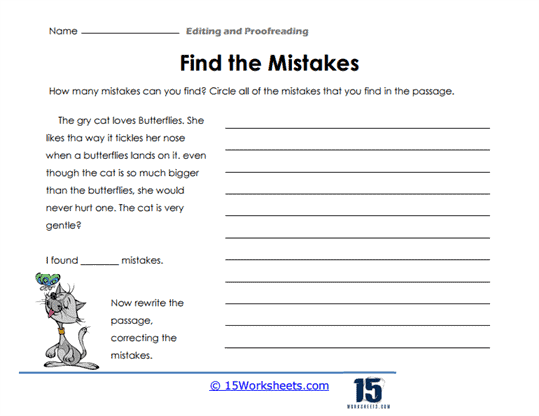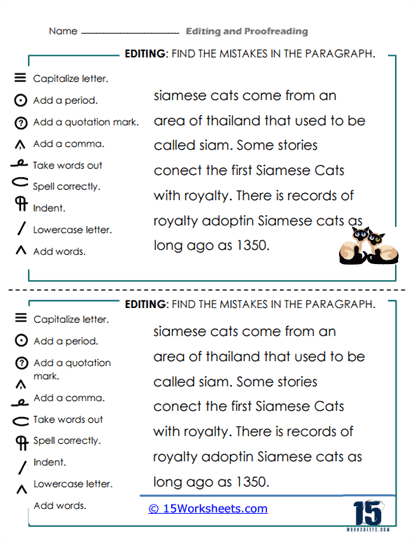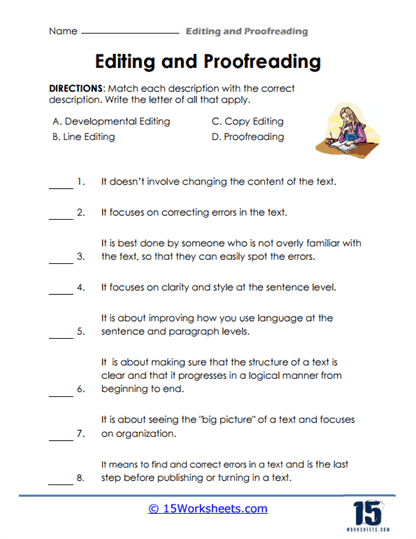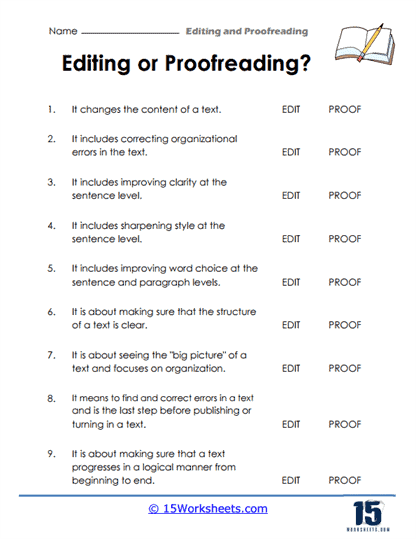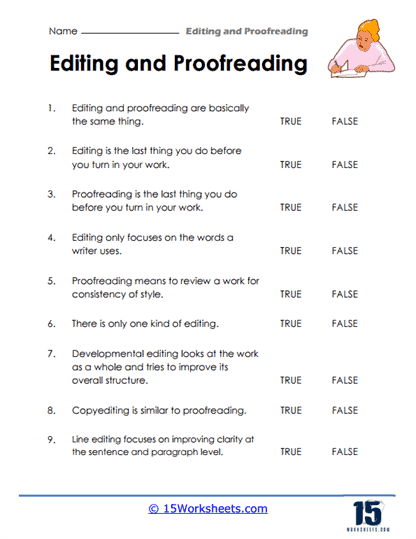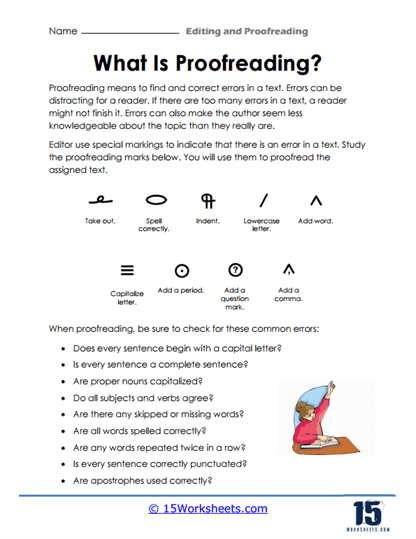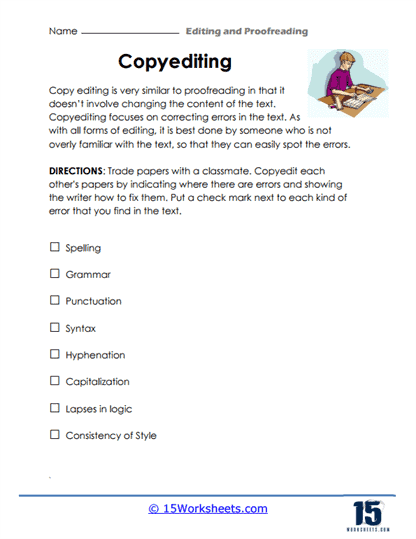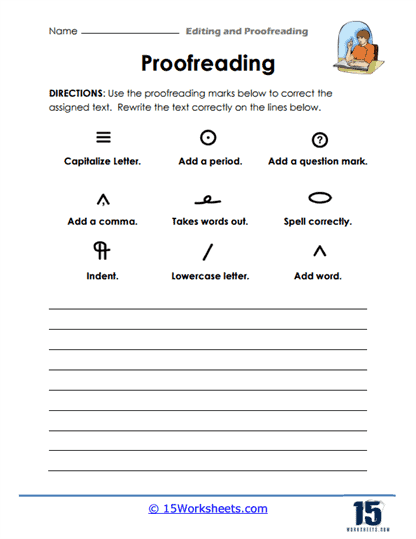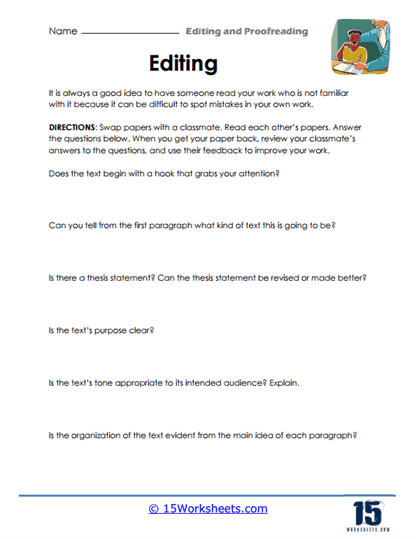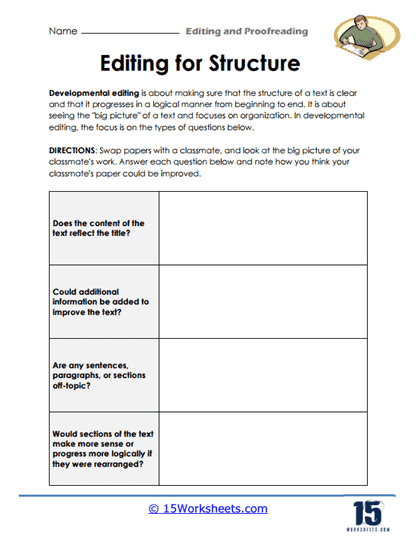Editing and Proofreading Worksheets
All About These 15 Worksheets
In the realm of writing, the journey from a rough draft to a polished, professional piece is not just about creativity or content-it’s also about precision. This is where editing and proofreading come into play, essential skills that separate compelling, coherent writing from something riddled with mistakes or inconsistencies. One of the most effective ways to build these skills is through the use of specialized worksheets that challenge individuals to review and revise passages full of common errors. These worksheets are far more than mere exercises; they serve as powerful tools in honing a writer’s ability to communicate clearly and accurately.
The passages or paragraphs in these worksheets typically contain a variety of mistakes-ranging from grammatical errors to punctuation mishaps, spelling issues, and even unclear or awkward sentence structures. Each worksheet provides a unique opportunity for learners to actively engage with flawed text, pinpointing mistakes that may seem minor but can significantly impact the quality of the writing. Whether for students, aspiring writers, or even professionals seeking to fine-tune their skills, these exercises offer hands-on practice in the meticulous art of editing and proofreading. As individuals work through these worksheets, they develop an eye for detail, a trait that is invaluable not only in writing but in any profession requiring precision and clarity.
The primary goal of editing and proofreading worksheets is not just to fix errors but to cultivate a deeper understanding of what makes writing effective. They encourage individuals to think critically about every aspect of a sentence-how it is structured, how the words flow, and whether the ideas being expressed are conveyed in the most efficient and engaging manner possible. For many, these worksheets reveal patterns in their own writing, showing where they tend to make consistent mistakes, and where they can improve their techniques. The impact goes beyond identifying errors; it’s about mastering the art of self-revision, a skill that can lead to significant improvements in both writing confidence and competency.
In editing worksheets, individuals are tasked with identifying and correcting a wide range of mistakes. These could include grammatical issues such as subject-verb agreement, misplaced modifiers, or incorrect verb tenses. Punctuation, another critical element of clear writing, is also a common focus. Writers learn to spot misused commas, periods, or quotation marks, all of which can change the meaning of a sentence or make it more difficult to follow. Spelling, while seemingly straightforward, remains a common stumbling block, especially when homophones or less commonly used words are involved. Capitalization and usage errors, which can often seem like small oversights, are brought into the spotlight, teaching writers to be more mindful of even the tiniest details.
But editing isn’t just about fixing mistakes. It’s also about improving the overall quality of the text. These worksheets often encourage individuals to rethink sentence structure, eliminate redundancy, and choose more precise or impactful words. For instance, an editing exercise might prompt someone to replace a vague, overused adjective with one that adds depth and color to the description. By doing so, the individual not only corrects the mistake but also enhances the reader’s experience, making the writing more engaging and memorable.
A Look At These Worksheets
Editing and proofreading may not sound like the stuff of legends, but enter this magical realm of red pens and misplaced commas, and you’ll discover a universe where students wield punctuation like swords and vanquish run-on sentences with a flick of their grammatical wrist. This worksheet collection is a grand initiation into the sacred rites of revision. In “Correct The Mistakes” and “Passage Proofread,” students begin their journey with full-length passages riddled with sneaky errors-typos, grammar gremlins, and awkward phrasing just waiting to be exorcised. It’s part scavenger hunt, part detective work, and part “Why did the author think ‘there’ was the right ‘their’?”
Next, our young language warriors are thrown into a whirlwind of more active and targeted drills. “Counting Errors” turns editing into a sport-can you find all seven errors hiding in the paragraph? Spoiler: you’ll probably miss one and spend twenty minutes debating if an Oxford comma counts. In “Circle and Revise,” students go full proofreader-mode, circling mistakes like they’re catching typos in the wild. Then comes “Legend Markers,” where students learn to annotate texts with cryptic editorial runes (also known as proofreading marks), which is basically learning an ancient language that only English teachers and overachievers still use.
With their newfound editing tools, students graduate to the wizard-level worksheets-“Use Editing Marks” and “Matching Descriptions.” These sheets challenge students to use those hieroglyphic proofreading marks to transform messy text into literary gold. And in “Edit Or Proof?“, they face a philosophical crisis: what is the difference between editing and proofreading? It’s like asking if cereal is soup-deceptively simple, emotionally complex, and ultimately divisive.
Just when you thought it couldn’t get more existential, students are thrust into the moral gray areas of language with “True or False” and “What Is Proofreading?“, where they must confront the nature of truth in punctuation and whether passive voice is truly evil or just misunderstood. In “Copyediting,” they take on a professional role-channeling their inner magazine editor as they correct and clarify writing with a sharp, judgmental eye and maybe a cappuccino in hand. “Text Revision” and “Read And Review” stretch their mental muscles even further, asking them to not just find errors, but improve the overall flow, clarity, and tone of a piece. Because grammar isn’t everything; sometimes it’s about not sounding like a robot.
In the dramatic third act of this literary hero’s journey, students engage in “Swap And Suggest” and “Structure Improvement,” which require empathy, critical thinking, and the rare skill of tactful peer feedback. Here, they don’t just edit-they collaborate, improve, and become champions of clarity. Because nothing says “maturity” like gently telling someone their sentence structure is a flaming train wreck. These worksheets give students not just tools, but a mission: to make writing better, funnier, and maybe just a little more human.
So yes, editing and proofreading might seem like the broccoli of English class. But with this epic series, it’s more like broccoli dipped in sarcasm and roasted in the fire of deep introspection. Behind every dangling modifier is a life lesson. Behind every missing period is a chance for redemption. And behind every worksheet? A future grammar nerd, forged in the fires of misplaced apostrophes.
What is Editing and Proofreading in Writing?
Editing and proofreading are two vital steps in the process of producing a well-written, high-quality piece of work. Although these terms are sometimes used interchangeably, they actually involve different activities and goals.
Editing
Editing comes before proofreading and is the process of reviewing and changing a text with the goal of improving the flow and overall quality of the writing. It involves making revisions to the text to enhance clarity, readability, coherence, and overall presentation. This could involve rephrasing sentences, altering word choice, adjusting the structure of the document, or even changing whole paragraphs around.
Checking if the content is organized and the message is clear is a key aspect. This involves looking at the overall structure, paragraph transitions, and maintaining a consistent style and tone. You also want to ensure clarity in language, correct and effective use of vocabulary, and maintaining a consistent language style. It may be helpful to rephrase sentences to improve readability.
An editor will ensure that the text is logically organized and flows well. This could involve altering the sequence of paragraphs, cutting out redundant information, or expanding areas that need more detail. In some higher level instances you will need to ensure that the text adheres to the prescribed guidelines of a specific writing style (APA, MLA, Chicago, etc.) This includes citations, formatting of headings and subheadings, lists, and other stylistic requirements.
Proofreading
Proofreading is the final stage of the writing process, focusing on surface errors such as misspellings and mistakes in grammar and punctuation. It should be done only after all other editing revisions have been made. In proofreading, the focus is not on making major changes to improve the flow or clarity of the text but on correcting minor errors.
You want to main proper grammar, punctuation, and spelling. This involves checking the document for correct usage of things like commas, periods, capitalization, sentence structure, verb tense, and other grammatical aspects. Spell-check tools can help identify misspellings, but they are not 100% reliable, so manual checking is always necessary.
While these processes can be done by the same person, they often require different skills and mindsets. An editor needs to be good at seeing the big picture elements of the text, while a proofreader needs to have a keen eye for detail.




